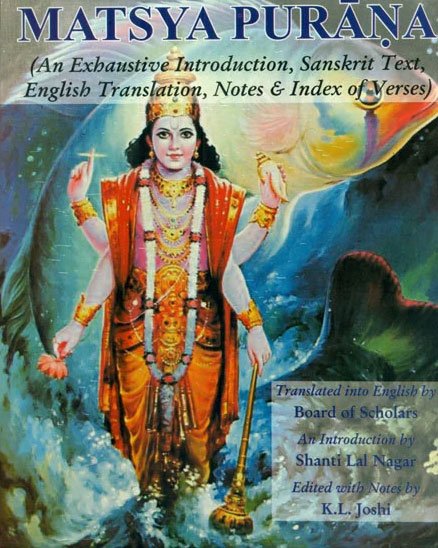The Matsya Purana (critical study)
by Kushal Kalita | 2018 | 74,766 words | ISBN-13: 9788171103058
This page relates ‘Different names of Shiva’ of the English study on the Matsya-purana: a Sanskrit text preserving ancient Indian traditions and legends written in over 14,000 metrical verses. In this study, the background and content of the Matsyapurana is outlined against the cultural history of ancient India in terms of religion, politics, geography and architectural aspects. It shows how the encyclopedic character causes the text to deal with almost all the aspects of human civilization.
Part 2.2 - Different names of Śiva
The Matsyapurāṇa has enumerated different names and epithets of Śiva. Moreover, this Purāṇa has given the significance of some of these names. Being attacked by the demons of Tripura the gods approached Śiva and prayed to him for their protection. They praised Śiva mentioning his different names and epithets. Śiva is Bhava, Sarva, Rudra,Varodā, Paśupati, Ugra, Kapardin, Mahādeva, Bhīma, Tryambaka, Śānta, Īśāna, Bhayaghna, Andhakaghātin, Nīlagrīva, Bhīma Śūlin, Uraga, Trinetra etc.[1]
Śukrācārya the preceptor of Daityas prayed to Śiva with many epithets and with many adjectives. Śukrācārya after getting the boon from Śiva praised Him with the epithets: Śitikaṇṭha, Kaniṣṭha, Suvarccā, Lelihāna, Kāvya, Vatsara, Lord of Andhasa, Kapardī, Karāla, Haryakṣa, Varada, Saṃstuta, Sutīrtha, Devadeva), Raṃhas, Uṣṇīṣī, Subaktra, Bahurūpa, Vedhā, Vasuretā, Rudra, Tapas, Citravāsā, Hrasva, Muktakeśa, Senānī, Rohita, Kavi, Rājvṛkṣa, Takṣakakrīḍana, Sahasraśirā, Sahasrākṣa, Mīḍhus, Vara, Bhavyarūpa, Śveta, Puruṣa, Girīśa, Arkabalī, Ājyapā, Sutṛpta, Suvastra, Dhanvī, Bhārgava, Niṣangī, Tāra, Svakṣa, Kṣapaṇa, Tāmra, Bhīma, Ugra, Śiva, Mahādeva, Sarva, Viśvarūpa, Hiraṇya, Variṣṭha, Jyeṣṭha, Madhyama, Vastospati, Pināka, Mukta, Kevala, Mṛgavyādha, Dakṣa, Sthāṇu, Bhāṣaṇa, Bahunetra, Dhurya, Trinetra, Īśvara, Kapālī, Vīra, Mṛtyu, Traymbaka, Piśaṅga, Piṅgala, Aruṇa, Pinākī, Iṣumat, Citra, Dundubhya, Ekapāda, Aja, Buddhida, Āraṇya, Gṛhastha, Yati, Brahmacārī, Sāṃkhya, Yoga, Vyāpī, Anāhata, Śarva Bhaveśa, Yama, Medhā, Cekitāna, Brahmiṣṭha, Maharṣi, Catuṣpād, Medhya, Rakṣī, Śīghraga, Śikhaṇḍī, Karāla, Daṅṣṭrī, Viśvavedhā, Bhāskara, Sudīpta, Sumedhā, Krura, Avikṛta, Bhīṣaṇa, Śiva, Saumya, Mukhya, Dhārmika, Śubha, Abadhya, Amṛta, Nitya, Śāśvata, Vyāpṛta, Biśiṣṭa, Bharata, Sākṣī, Kṣema, Sahamāna, Satya, Anṛta, Kartā, Paraśu, Śūlī, Divyacakṣu, Somapā, Ājyapā, Dhumapā, Uṣmapā, Śucī, Paridhāna, Sadyojāta, Piśitāśa, Sarba, Megha, Vidyuta, Vyāvṛtta, Variṣṭha, Bhārata, Tarakṣu, Tripuraghna, Tīrtha, Avakra, Romaśa, Tigmāyudha, Vyākhya, Susiddha, Pulasti, Rocamāna, Caṇḍa, Sphīta, Ṛsabha, Vratī, Yuñjamāna, Asuraghna, Svāghna, Mṛtyughna, Yajñiya, Paśughna, Avighna, Śvasita, Vibhrānta, Mahānta, Durgama, Kṛṣṇa, Jayanta, Lokeśa, Anāśrita, Vedhya, Samatvādhiṣṭhita, Hiraṇyabāhu, Vyāpta, Maha, Sukarmā, Prasahya, Īśāna, Sucakṣu, Kṣipreṣu, Sadaśva, Mokṣada, Kapila, Piśaṅga, Dhīmān, Mahākāya, Dīpta, Rodana, Saha, Dhṛḍadhanvā, Kavacī, Rathī, Varūthī, Bhṛgunātha, Śukra, Gahvariṣṭha, Vedhā, Amogha, Praśānta, Sumedhā, Vṛṣa, Paśupati. Bhūtapati, Praṇava, Svadhā, Vasu, Sādhya, Rudra, Āditya, Māruta, Devātmā, Svayambhū, Prajāpati, Brahmātmā, Ātmeśa, Ātmavaśya, Sarveśātiśaya, Nirguṇa, Guṇajña, Vyākṛta, Nirupākhya, Mitra, Saṃkhyātmā, Lokātmā, Nitya, Ātamliṅga, Sūkṣma and Asūkṣma, Buddha, Bibhu.[2]
The names of Śiva, such as Tripurāri, Dhurjaṭi, Nīlakaṇṭha, Śrīkaṇṭha, Sitikaṇṭha etc. are given as per his deeds. He is Nīlakaṇṭha i.e blue-throated as He has drunk the dangerous kālakūṭa poison which came out at the time of churning of ocean.[3] His favourite weapon is a triśūla and hence his epithets -Śūladhṛt, Śūladhara.[4] The name of his bow is Pināka and hence his epithet Pinākin or Pinākadhṛk.[5] This bow is also known as Ajagava.[6] He used to keep skull (kapāla) with him and therefore he is known as Kapālin.[7] Being of a smokey red colour He is called Dhumralohita.[8] His abode is Kailāsa on the mountain Himalayas.[9] Hence he is known as Girīśa.[10] He is also known as Bhairava. Matsyapurāṇa has discussed elaborately the Bhairava-māhātmya in the 179th chapter of this Purāṇa. In this Bhairava form, He is said to guard Avimukta and persons worshipping him. Śiva is also known for his genderless form as Ardhanārīśa.[11]
Footnotes and references:
[1]:
,132.22-28
[2]:
Ibid., 47.128-166
[3]:
Ibid., 250.13-61
[4]:
Ibid., 11.19; 23.19.
[5]:
Ibid., 23.36; 69.1; 60.11; 95.16
[6]:
Ibid., 23.37
[7]:
,153.38
[8]:
Ibid., 121.22
[9]:
Ibid., 54.3; 121.1-2
[10]:
Ibid., 23.36
[11]:
Ibid., 60.25
